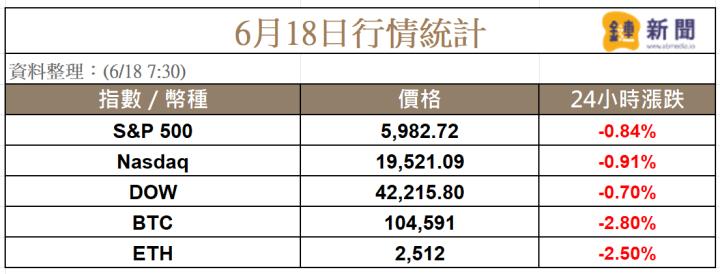Author: BitpushNews
On Wednesday afternoon local time (June 18), the Federal Reserve announced that it would maintain the benchmark interest rate at 4.25%-4.50%, unchanged for the fourth consecutive meeting, fully in line with market expectations.
The Fed stated that while uncertainty about economic prospects has somewhat decreased, it remains at a high level. Meanwhile, the Fed lowered its 2025 US GDP growth forecast to 1.4% and raised its inflation expectation to 3%. This indicates that the Fed continues to face a dilemma between economic recovery and inflation control.
Rate cut expectations have also been adjusted: the Fed's "dot plot" shows that while two rate cuts (totaling 50 basis points) are still expected in 2025, consistent with March's projection, the rate cut expectation for 2026 has been reduced from two to one (only 25 basis points). Notably, among the 19 Fed officials, 7 believe there will be no rate cuts in 2025, revealing significant internal disagreement about the future policy path.

Crypto Market: Undercurrents Beneath a Calm Surface
Despite the Fed's decision having a massive impact on global financial markets, the cryptocurrency market's reaction appears somewhat "zen". Bitcoin (BTC) remains around $104,000, Ethereum (ETH) hovers at $2,520, while XRP and Solana remain relatively stable.

According to CoinGlass data, while the total cryptocurrency market cap slightly dropped 2% to $3.35 trillion that day, a significant $224 million in leverage liquidations occurred, with Ethereum having the largest liquidation volume, followed by Bitcoin. This indicates an intense ongoing battle between bulls and bears.
It's worth noting that the US spot Bitcoin ETF recorded a net inflow of $216 million on June 17, while the spot Ethereum ETF saw an inflow of $11 million. This suggests that institutional funds continue to enter the crypto market, providing support at the bottom.
Market experts believe this "calm" reaction reflects investors' cautious sentiment after the Fed's decision, with everyone waiting for clearer macroeconomic signals.
Trump Criticizes Powell Again: Political Factors Intertwined with Market Judgment
Interestingly, on the day of the Fed meeting, Trump again publicly attacked Fed Chairman Jerome Powell, calling him "stupid" and predicting the Fed would not cut rates. Trump has long criticized Powell, accusing him of policies that "cost the country a lot of money". He believes Europe has cut rates 10 times while the US has not cut at all, and questions Powell's political stance.
While these political remarks have drawn attention, they currently have not caused a direct massive impact on the crypto market, which seems more focused on economic data itself.
Global Tensions Escalating, Why is the Crypto Market Calm?
NoOnes CEO Ray Yossef pointed out that despite escalating tensions in the Middle East and macro environment turbulence over the past week, cryptocurrency prices have barely moved.
He explained that Bitcoin remains stable in a narrow range around $105,000, with daily volatility below 2.1%, and no large-scale panic selling has occurred.
Ray Yossef also warned against overlooking escalating macro risks. He emphasized: "If geopolitical tensions intensify or begin to affect the financial system through sanctions, infrastructure disruption, or capital controls, the crypto market will not be spared." He noted that Bitcoin's market dominance is approaching 66%, indicating that investors' risk appetite for Altcoins is decreasing in the current environment.
On-Chain Data Reveals: Bitcoin Scarcity Intensifying
Beyond price and macroeconomic factors, on-chain data also provides an interesting perspective.
According to data from DeFi solution provider Sentora (formerly IntoTheBlock), Bitcoin's Market Value to Realized Value (MVRV) Ratio remains below historical market peaks.
The MVRV Ratio is an indicator measuring the ratio of Bitcoin's total market cap to the total value of all Bitcoins at their last on-chain movement (the "realized value"). It reflects whether network investors are overall profitable or at a loss.

Data shows that Bitcoin's MVRV Ratio's extreme peaks have historically coincided with asset price tops, as high MVRV values indicate average investors hold significant profits and are more likely to take profits. Currently, Bitcoin's MVRV Ratio is 2.25, meaning the market cap is over twice the realized value, but this is significantly lower compared to past cyclical tops. This suggests the market is not as overheated as before, and Bitcoin still has potential for growth.
Fidelity Digital Assets' research report on June 18 noted that Bitcoin's "Ancient Supply" is growing faster than new daily Bitcoin issuance.

"Ancient Supply" refers to Bitcoins untouched for at least ten years. Since April 2024, an average of 566 Bitcoins daily have entered the "over ten years" unused category, exceeding the 450 new Bitcoins miners add daily. This occurs less than a year after the 2024 block reward halving, which directly halves issuance and fundamentally changes Bitcoin's supply dynamics.
"Ancient Supply" currently represents over 17% of all mined Bitcoins, valued at around $360 billion. Although Satoshi Nakamoto holds 33% of this, and some Bitcoins might be permanently lost, analysts point out that any coin could potentially be reactivated.
Fidelity's report also mentioned the "HODL rate" (Ancient Supply inflow minus new issuance). This indicator turned positive in April 2024, averaging an increase of 116 Bitcoins daily, further confirming that core holders are absorbing circulating Bitcoins faster than miners produce them.
Fidelity predicts that based on current trends, by 2035, "Ancient Supply" will exceed 30% of circulating Bitcoin supply. While this scarcity doesn't directly guarantee price appreciation (demand support is needed), the continued increase of Bitcoin controlled by long-term holders will tighten the supply available to traders, making price discovery increasingly dependent on marginal flow.
The report concludes that Bitcoin is now distinguished from commodities with elastic supply. Its scarcity, combined with long-term holding and lost tokens, is expected to increase over time. If future demand grows simultaneously, this characteristic might reshape its value discovery logic, becoming a core advantage distinguishing it from other assets.







